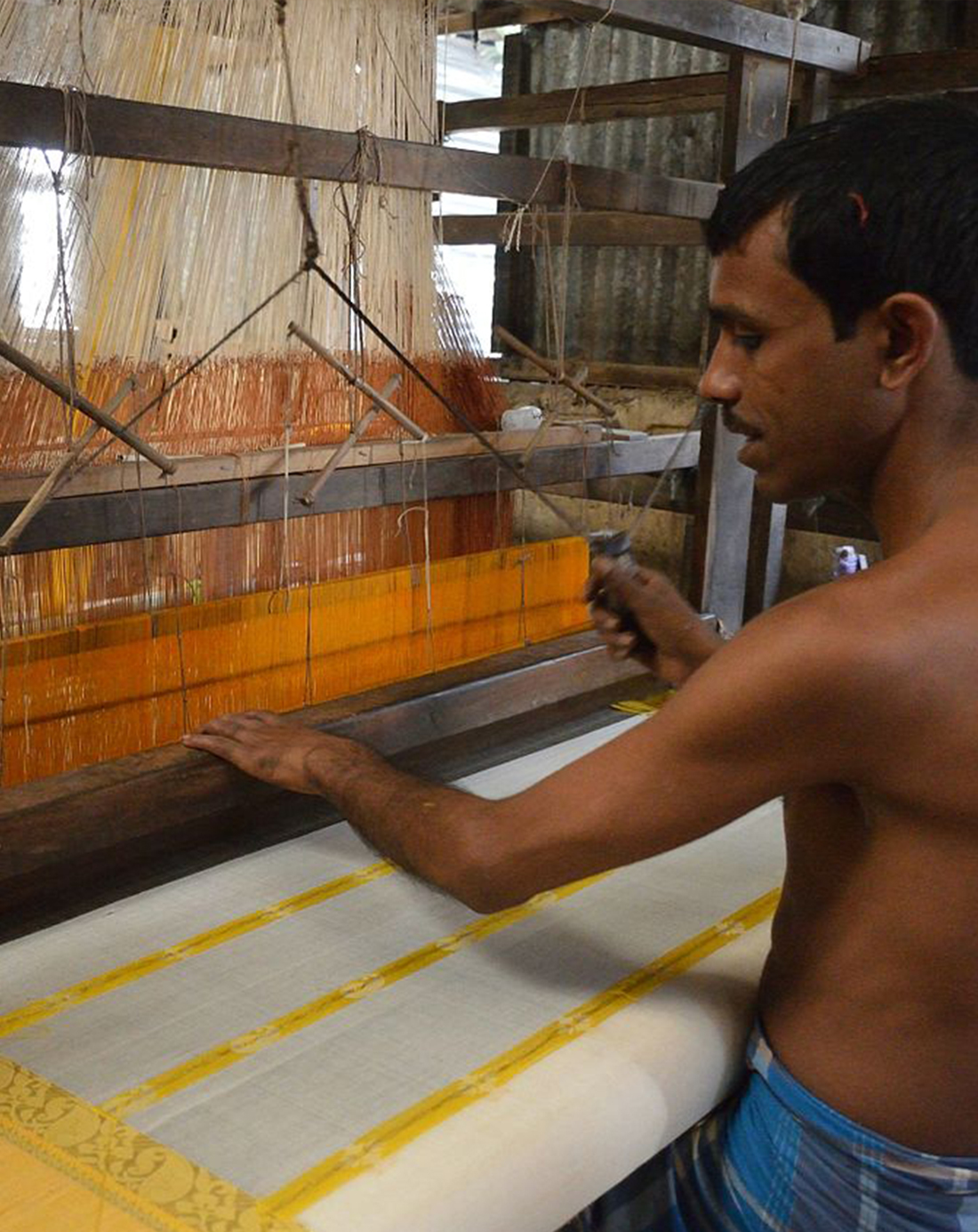Your basket is currently empty!

Gandhi adopted Khadi as a political iconography in protest against British mill-made cotton. In the 21st century, Gandhi’s anti-Colonial Swadeshi politics are garnished with the ethos of sustainability, dressed with notions of handmade luxury, and marketed as the beacon of hope to uplift the indigenous weavers of India. Khadi’s share in textile production has doubled in the last five years. While the handlooms movement has empowered various elite sections of the Indian textile industry, the weavers, however, continue to remain underpaid labourers often working in hazardous environment.
POWERLOOM VS HANDLOOM
Looms operated with the aid of electric power for the manufacturing of cloth are called as Powerlooms whereas the Handlooms are looms operated without aid of power. The elite-castes owned powerloom sector roughly accounts for 60% of fabric production in India whereas the oppressed-castes dominated the handloom sector despite employing a whopping 11 million indigenous artisans, contributes to 15% of fabric production. While the Government of India protects the interests of the handloom sector from the encroachment of the powerloom industry by way of reserving certain specifications for exclusive production by handlooms (Handlooms Reservation of Articles for Production Act, 1985), the need to nurture powerloom industries were also addressed simultaneously by the state.
“The hand loom worker was lured with the carrot of sops to race on a bullock cart on a road that moved much faster than his vehicle, and against a competitor who drove a racing car. It was a race that was illogical, the hand operated loom can never be as productive as the mechanized, power driven mill. It can never achieve the economies of scale required to compete in a commoditized market, because the hand loom is a lone worker and his family, not an organization like the mill.” – Round Table India
When I visited Benaras craft clusters in the early 2010s, inadequate wages and resultant high-job dropout rates were the biggest concerns bothering handloom weavers on the ground reality. The weavers at Benaras were then paid a meagre wage averaging about Rs.150 per day. A recent study by the Centre for Handloom Information and Advocacy in Andhra Pradesh found that 55% of weavers’ families earn less than Rs 1,000 a month. Handloom weavers are forced to look out for other jobs with better pay and there’s no bigger loss to the craft than the loss of such highly skilled artisans & craftsmen. Gandhi championed Khadi in colonial India to compete British-mill made goods. Average Indian weavers still don’t have access to the power-driven machines the British used even 70 years ago!
ETHICAL FASHION & GANDHIAN HANDLOOMS
Small scale industries are scattered and largely supported by individuals (and immediate family) unlike the powerloom mills operated in larger scales. Loss of eyesight due to inadequate lighting conditions is alarmingly common among handloom weavers.
“The hand-mill gives you society with the feudal lord” – Karl Marx
Craft specific labour groups like the handloom-weavers, as well as the hegemony of elite classes in powerloom sectors, are salient characteristics of Varnashrama society.
UPDATE: LINKS À LA MODE, AUGUST 9TH, 2019
This post was featured on Links à la Mode fashion roundup by Independent Fashion Bloggers.
More fashion articles:
- 5 Ways to Style Leopard Print Shorts by Season’s Best
- Gandhian handlooms – revival of typewriter culture in 5g era by Purushu Arie
- Caravan Diaries by the Fleamarket Queen
SPONSOR: Shopbop, Equipment, Alexis Clothing, Nicholas Dresses,
AqC, La Double J, KAANAS, Big Hoops, Tie Dye, Box Bags, Men’s Ksubi
19 responses to “Handlooms, Weavers, and Ethical Fashion”
We cross-generation after generation. But handcraft is the best quality that we provide. Thanks for this article. Keep it up.
We need more article like this.
Thanks for sharing us yours precious time to create this post, its so informative and the content make post more interesting. really appreciated.
The native concept and modern machinery would be the best way to improve the culture.
well narrated
Indian art is very different. The way you are representing it is really nice. Your work and research are really great. I love this article.
Good Article Thank You So Much.
its the history of indian culture
I like your article. Such I love Indian art because it is different from other arts.
Very beautiful information
Very nice and rich information in this article. Thanks sir.
Great information in this post. I bookmark this website for regular visits.
Amazing post…keep sharing like this
In INDIA Handloom Clothes are very famous & Mostly used in the Villages, Thanks.
Good post, your article is really nice, love it!
This article helps to understand differences between powerloom vs handloom. Thanks!!!
This is very unique . Thanks for putting lights on traditional methods of ancient India. Thanks for sharing.
People only see the beautiful clothing and the person who is wearing it, but to make that person and the cloth beautiful there are people working really hard and these people have the unparallel skill, we should appreciate the hard work of these artisans and make them recognizable throughout, thank you so much for bringing this topic to light purushu.com
very impotent information

Leave a Reply